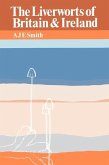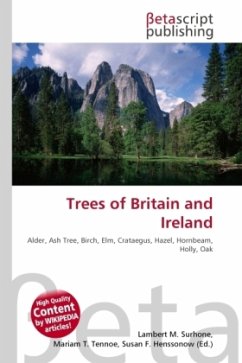- Gebundenes Buch
- Merkliste
- Auf die Merkliste
- Bewerten Bewerten
- Teilen
- Produkt teilen
- Produkterinnerung
- Produkterinnerung
The final volume of this definitive flora, with full descriptions for all species and infraspecific taxa, including newly described ones.
Andere Kunden interessierten sich auch für
![Flora of Great Britain & Ireland v4 Flora of Great Britain & Ireland v4]() Peter SellFlora of Great Britain & Ireland v4201,99 €
Peter SellFlora of Great Britain & Ireland v4201,99 €![The British Ferns, Or, Colored Figures And Descriptions With The Needful Analyses Of The Fructification And Venation Of The Ferns Of Great Britain And Ireland The British Ferns, Or, Colored Figures And Descriptions With The Needful Analyses Of The Fructification And Venation Of The Ferns Of Great Britain And Ireland]() The British Ferns, Or, Colored Figures And Descriptions With The Needful Analyses Of The Fructification And Venation Of The Ferns Of Great Britain And Ireland35,99 €
The British Ferns, Or, Colored Figures And Descriptions With The Needful Analyses Of The Fructification And Venation Of The Ferns Of Great Britain And Ireland35,99 €![The Liverworts of Britain and Ireland The Liverworts of Britain and Ireland]() A. J. E. SmithThe Liverworts of Britain and Ireland91,99 €
A. J. E. SmithThe Liverworts of Britain and Ireland91,99 €![The British flora medica, or, History of the medicinal plants of Great Britain (Volume II) The British flora medica, or, History of the medicinal plants of Great Britain (Volume II)]() Benjamin H. BartonThe British flora medica, or, History of the medicinal plants of Great Britain (Volume II)38,99 €
Benjamin H. BartonThe British flora medica, or, History of the medicinal plants of Great Britain (Volume II)38,99 €![Flora of Great Britain and Ireland: Volume 5, Butomaceae - Orchidaceae Flora of Great Britain and Ireland: Volume 5, Butomaceae - Orchidaceae]() Peter SellFlora of Great Britain and Ireland: Volume 5, Butomaceae - Orchidaceae266,99 €
Peter SellFlora of Great Britain and Ireland: Volume 5, Butomaceae - Orchidaceae266,99 €![Flora Britannica Indigena, Or, Plates of the Indigenous Plants of Great Britain Flora Britannica Indigena, Or, Plates of the Indigenous Plants of Great Britain]() John WalcottFlora Britannica Indigena, Or, Plates of the Indigenous Plants of Great Britain40,99 €
John WalcottFlora Britannica Indigena, Or, Plates of the Indigenous Plants of Great Britain40,99 €![Trees of Britain and Ireland Trees of Britain and Ireland]() Trees of Britain and Ireland22,99 €
Trees of Britain and Ireland22,99 €-
-
-
The final volume of this definitive flora, with full descriptions for all species and infraspecific taxa, including newly described ones.
Produktdetails
- Produktdetails
- Verlag: Cambridge University Press
- Seitenzahl: 850
- Erscheinungstermin: 6. März 2019
- Englisch
- Abmessung: 250mm x 175mm x 50mm
- Gewicht: 1617g
- ISBN-13: 9780521553353
- ISBN-10: 0521553350
- Artikelnr.: 50435498
- Herstellerkennzeichnung
- Libri GmbH
- Europaallee 1
- 36244 Bad Hersfeld
- gpsr@libri.de
- Verlag: Cambridge University Press
- Seitenzahl: 850
- Erscheinungstermin: 6. März 2019
- Englisch
- Abmessung: 250mm x 175mm x 50mm
- Gewicht: 1617g
- ISBN-13: 9780521553353
- ISBN-10: 0521553350
- Artikelnr.: 50435498
- Herstellerkennzeichnung
- Libri GmbH
- Europaallee 1
- 36244 Bad Hersfeld
- gpsr@libri.de
Peter Sell (1929-2013) joined the Herbarium in the University of Cambridge's Department of Plant Sciences in 1944, holding the post of Assistant Curator from 1972 until his retirement in 1997. From 1997 to 2013 his work there on this flora continued unabated, together with frequent visits to the University's Botanic Garden throughout the flowering and fruiting seasons. He was co-author of A Flora of Cambridgeshire (Cambridge, 1964) and A Flora of the Maltese Islands (1977), and was involved in the whole Flora Europaea project, also published in five volumes (Cambridge, 1964-80).
Foreword
Preface and Acknowledgements
The Cambridge School of Plant Taxonomy
Introduction
Conspectus of families
1. Lycopodiaceae
2. Selaginellaceae
3. Isoetaceae
4. Equisetaceae
5. Ophioglossaceae
6. Osmundaceae
7. Adiantaceae
8. Pteridaceae
9. Marsileaceae
10. Hymenophyllaceae
11. Polypodiaceae
12. Cyatheaceae
13. Dicksoniaceae
14. Dennstaedtiaceae
15. Thelypteridaceae
16. Aspleniaceae
17. Woodsiaceae
18. Davalliaceae
19. Dryopteridaceae
20. Blechnaceae
21. Azollaceae
21A. Ginkgoaceae
22. Pinaceae
23. Taxodiaceae
24. Cupressaceae
25. Araucariaceae
26. Taxaceae
26A. Cephalotaxaceae
27. Magnoliaceae
28. Lauraceae
28A. Saururaceae
29. Aristolochiaceae
30. Nymphaeaceae
30A. Cabombaceae
31. Ceratophyllaceae
32. Ranunculaceae
33. Berberidaceae
34. Papaveraceae
35. Fumariaceae
36. Platanaceae
37. Ulmaceae
38. Cannabaceae
39. Moraceae
40. Urticaceae
41. Juglandaceae
42. Myricaceae
43. Fagaceae
44. Betulaceae
45. Corylaceae
46. Phytolaccaceae
46A. Nyctaginaceae
47. Aizoaceae
48. Chenopodiaceae
49. Amaranthaceae
50. Portulacaceae
51. Basellaceae
52. Caryophyllaceae
53. Polygonaceae
54. Plumbaginaceae
55. Paeoniaceae
56. Elatinaceae
57. Hypericaceae
58. Tiliaceae
59. Malvaceae
60. Sarraceniaceae
61. Droseraceae
62. Cistaceae
63. Violaceae
64. Tamaricaceae
65. Frankeniaceae
66. Cucurbitaceae
67. Salicaceae
New taxa and combinations
Abbreviations
Glossary
Indexes.
Preface and Acknowledgements
The Cambridge School of Plant Taxonomy
Introduction
Conspectus of families
1. Lycopodiaceae
2. Selaginellaceae
3. Isoetaceae
4. Equisetaceae
5. Ophioglossaceae
6. Osmundaceae
7. Adiantaceae
8. Pteridaceae
9. Marsileaceae
10. Hymenophyllaceae
11. Polypodiaceae
12. Cyatheaceae
13. Dicksoniaceae
14. Dennstaedtiaceae
15. Thelypteridaceae
16. Aspleniaceae
17. Woodsiaceae
18. Davalliaceae
19. Dryopteridaceae
20. Blechnaceae
21. Azollaceae
21A. Ginkgoaceae
22. Pinaceae
23. Taxodiaceae
24. Cupressaceae
25. Araucariaceae
26. Taxaceae
26A. Cephalotaxaceae
27. Magnoliaceae
28. Lauraceae
28A. Saururaceae
29. Aristolochiaceae
30. Nymphaeaceae
30A. Cabombaceae
31. Ceratophyllaceae
32. Ranunculaceae
33. Berberidaceae
34. Papaveraceae
35. Fumariaceae
36. Platanaceae
37. Ulmaceae
38. Cannabaceae
39. Moraceae
40. Urticaceae
41. Juglandaceae
42. Myricaceae
43. Fagaceae
44. Betulaceae
45. Corylaceae
46. Phytolaccaceae
46A. Nyctaginaceae
47. Aizoaceae
48. Chenopodiaceae
49. Amaranthaceae
50. Portulacaceae
51. Basellaceae
52. Caryophyllaceae
53. Polygonaceae
54. Plumbaginaceae
55. Paeoniaceae
56. Elatinaceae
57. Hypericaceae
58. Tiliaceae
59. Malvaceae
60. Sarraceniaceae
61. Droseraceae
62. Cistaceae
63. Violaceae
64. Tamaricaceae
65. Frankeniaceae
66. Cucurbitaceae
67. Salicaceae
New taxa and combinations
Abbreviations
Glossary
Indexes.
Foreword
Preface and Acknowledgements
The Cambridge School of Plant Taxonomy
Introduction
Conspectus of families
1. Lycopodiaceae
2. Selaginellaceae
3. Isoetaceae
4. Equisetaceae
5. Ophioglossaceae
6. Osmundaceae
7. Adiantaceae
8. Pteridaceae
9. Marsileaceae
10. Hymenophyllaceae
11. Polypodiaceae
12. Cyatheaceae
13. Dicksoniaceae
14. Dennstaedtiaceae
15. Thelypteridaceae
16. Aspleniaceae
17. Woodsiaceae
18. Davalliaceae
19. Dryopteridaceae
20. Blechnaceae
21. Azollaceae
21A. Ginkgoaceae
22. Pinaceae
23. Taxodiaceae
24. Cupressaceae
25. Araucariaceae
26. Taxaceae
26A. Cephalotaxaceae
27. Magnoliaceae
28. Lauraceae
28A. Saururaceae
29. Aristolochiaceae
30. Nymphaeaceae
30A. Cabombaceae
31. Ceratophyllaceae
32. Ranunculaceae
33. Berberidaceae
34. Papaveraceae
35. Fumariaceae
36. Platanaceae
37. Ulmaceae
38. Cannabaceae
39. Moraceae
40. Urticaceae
41. Juglandaceae
42. Myricaceae
43. Fagaceae
44. Betulaceae
45. Corylaceae
46. Phytolaccaceae
46A. Nyctaginaceae
47. Aizoaceae
48. Chenopodiaceae
49. Amaranthaceae
50. Portulacaceae
51. Basellaceae
52. Caryophyllaceae
53. Polygonaceae
54. Plumbaginaceae
55. Paeoniaceae
56. Elatinaceae
57. Hypericaceae
58. Tiliaceae
59. Malvaceae
60. Sarraceniaceae
61. Droseraceae
62. Cistaceae
63. Violaceae
64. Tamaricaceae
65. Frankeniaceae
66. Cucurbitaceae
67. Salicaceae
New taxa and combinations
Abbreviations
Glossary
Indexes.
Preface and Acknowledgements
The Cambridge School of Plant Taxonomy
Introduction
Conspectus of families
1. Lycopodiaceae
2. Selaginellaceae
3. Isoetaceae
4. Equisetaceae
5. Ophioglossaceae
6. Osmundaceae
7. Adiantaceae
8. Pteridaceae
9. Marsileaceae
10. Hymenophyllaceae
11. Polypodiaceae
12. Cyatheaceae
13. Dicksoniaceae
14. Dennstaedtiaceae
15. Thelypteridaceae
16. Aspleniaceae
17. Woodsiaceae
18. Davalliaceae
19. Dryopteridaceae
20. Blechnaceae
21. Azollaceae
21A. Ginkgoaceae
22. Pinaceae
23. Taxodiaceae
24. Cupressaceae
25. Araucariaceae
26. Taxaceae
26A. Cephalotaxaceae
27. Magnoliaceae
28. Lauraceae
28A. Saururaceae
29. Aristolochiaceae
30. Nymphaeaceae
30A. Cabombaceae
31. Ceratophyllaceae
32. Ranunculaceae
33. Berberidaceae
34. Papaveraceae
35. Fumariaceae
36. Platanaceae
37. Ulmaceae
38. Cannabaceae
39. Moraceae
40. Urticaceae
41. Juglandaceae
42. Myricaceae
43. Fagaceae
44. Betulaceae
45. Corylaceae
46. Phytolaccaceae
46A. Nyctaginaceae
47. Aizoaceae
48. Chenopodiaceae
49. Amaranthaceae
50. Portulacaceae
51. Basellaceae
52. Caryophyllaceae
53. Polygonaceae
54. Plumbaginaceae
55. Paeoniaceae
56. Elatinaceae
57. Hypericaceae
58. Tiliaceae
59. Malvaceae
60. Sarraceniaceae
61. Droseraceae
62. Cistaceae
63. Violaceae
64. Tamaricaceae
65. Frankeniaceae
66. Cucurbitaceae
67. Salicaceae
New taxa and combinations
Abbreviations
Glossary
Indexes.








